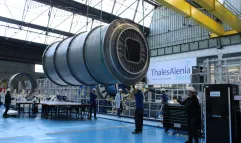On the 10th anniversary of Sentinel-1A, we celebrate the ever-growing number of Sentinel observations and their positive impact on society and the environment.
Since the launch of the first Sentinel-1 satellite on April 3, 2014, this mission’s all-weather, day/night radar imaging capability, combined with its systematic and global observations, has revealed the scale at which humans are impacting the environment and natural resources.

SENTINEL-1: benevolent eyes in the sky
A cornerstone of the Copernicus program, the Sentinel-1 satellites are designed to perform day/night imaging in all weather conditions, irrespective of cloud cover.
Sentinel-1 data serves a wide range of applications, from tracking changes in ice sheets and the Arctic environment to detecting landslides, mapping forests, monitoring water resources and land use, and aiding emergency response in the aftermath of natural disasters.
Each satellite has a payload comprising a C-band SAR instrument, which provides imagery with a spatial resolution down to 5 meters. Because the Sentinel-1 mission has two satellites flying in tandem, it offers better coverage and a shorter repeat cycle to meet user requirements. In the near future, Sentinel-1A will be joined by two more spacecraft in the series: Sentinel-1C and -1D.
These new spacecraft, together with the Copernicus Expansion missions, will complement the Sentinels already in orbit and advance our knowledge of large-scale natural and human-induced changes to the planet.
About Copernicus
The European Commission’s Copernicus environmental monitoring program is the most ambitious of its kind in the world, with 12 families of Sentinel satellites surveying Earth, its topography, seas, lakes, oceans, and polar regions. Copernicus also encompasses climatology missions and programs measuring human-induced CO2 emissions or affording new applications to foster sustainable agriculture and biodiversity. A program of this scale is key to enable Europe to better anticipate the consequences of global warming so that we can safeguard our planet. Thales Alenia Space is a major contributor to 11 of the program’s 12 missions.
The satellites are built by European prime contractors for the European Space Agency (ESA). Thales Alenia Space is prime contractor for the Sentinel-1 and Sentinel-3 satellite families. We’re also responsible for the Sentinel-2 image ground segment, and we helped to build the imaging spectrometer on Sentinel-5P and the Poseidon-4 radar altimeter on Sentinel-6. In 2020, Thales Alenia Space was awarded five contracts for the six new Copernicus Expansion missions, as prime contractor for the CIMR, ROSE-L and CHIME satellites, and supplier of the CRISTAL and CO2M mission payloads.


